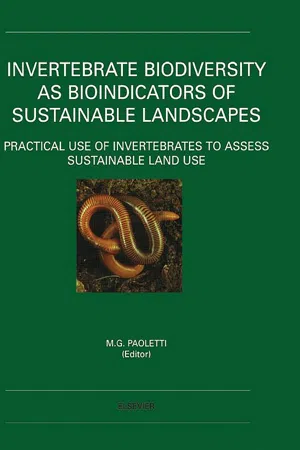
Invertebrate Biodiversity as Bioindicators of Sustainable Landscapes
Practical Use of Invertebrates to Assess Sustainable Land Use
Maurizio G. Paoletti
- 460 pages
- English
- ePUB (mobile friendly)
- Available on iOS & Android
Invertebrate Biodiversity as Bioindicators of Sustainable Landscapes
Practical Use of Invertebrates to Assess Sustainable Land Use
Maurizio G. Paoletti
About This Book
Reducing environmental hazard and human impact on different ecosystems, with special emphasis on rural landscapes is the main topic of different environmental policies designed in developed countries and needed in most developing countries.
This book covers the bioindication approach of rural landscapes and man managed ecosystems including both urbanised and industrialised ones. The main techniques and taxa used for bioindication are considered in detail. Remediation and contamination is faced with diversity, abundance and dominance of biota, mostly invertebrates.
Invertebrate Biodiversity as Bioindicators of Sustainable Landscapes provides a basic tool for students and scientists involved in landscape ecology and planning, environmental sciences, landscape remediation and pollution.
Frequently asked questions
Information
Diversity of Heteroptera in agroecosystems: role of sustainability and bioindication
1 Tel.: + 33-04-99-61-23-49; fax: + 33-04-67-52-15-54
Abstract
1 Introduction
Table of contents
- Cover image
- Title page
- Table of Contents
- Copyright page
- Foreword
- Using bioindicators based on biodiversity to assess landscape sustainability
- The ecological role of biodiversity in agroecosystems
- Biodiversity evaluation in agricultural landscapes: above-ground insects
- Bacterial diversity in agroecosystems
- Biodiversity of arbuscular mycorrhizal fungi in agroecosystems
- Soil protozoa as bioindicators: pros and cons, methods, diversity, representative examples
- Nematode diversity in agroecosystems
- The role of earthworms for assessment of sustainability and as bioindicators
- Woodlice (Isopoda: Oniscidea): their potential for assessing sustainability and use as bioindicators
- Use of soil dwelling Diptera (Insecta, Diptera) as bioindicators: a review of ecological requirements and response to disturbance
- Carabid beetles in sustainable agriculture: a review on pest control efficacy, cultivation impacts and enhancement
- Spiders (Araneae) useful for pest limitation and bioindication
- Diversity of Heteroptera in agroecosystems: role of sustainability and bioindication
- Neuroptera in agricultural ecosystems
- Biodiversity of predaceous coccinellidae in relation to bioindication and economic importance
- Syrphidae: can they be used as environmental bioindicators?
- Staphylinid beetles as bioindicators
- Pollinators as bioindicators of the state of the environment: species, activity and diversity
- Predatory mites (Gamasina, Mesostigmata)
- Oribatid mite biodiversity in agroecosystems: role for bioindication
- Ants as bioindicators of soil function in rural environments
- Subject Index, Volume 74
- Author Index, Volumes 74